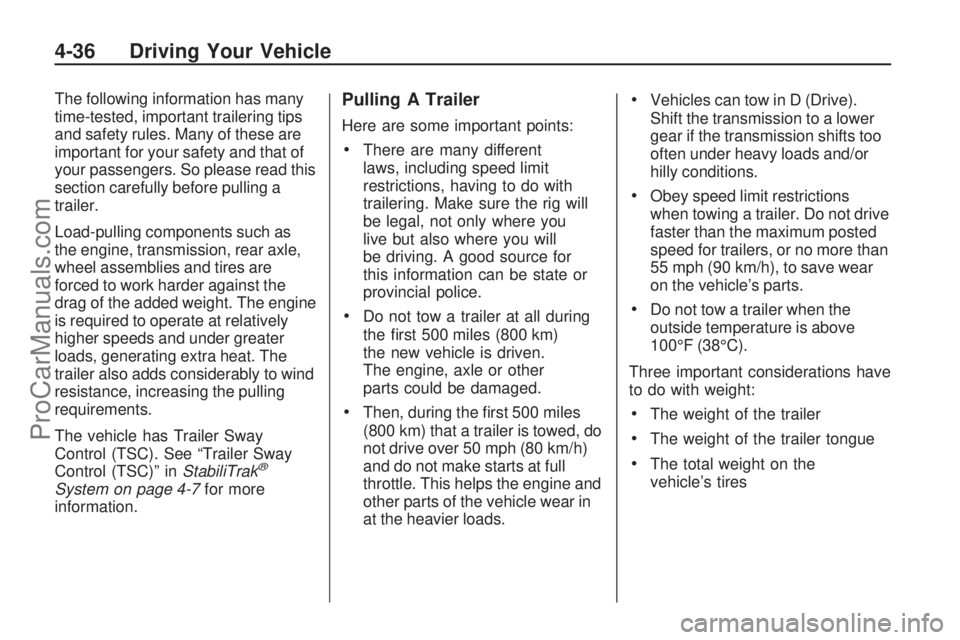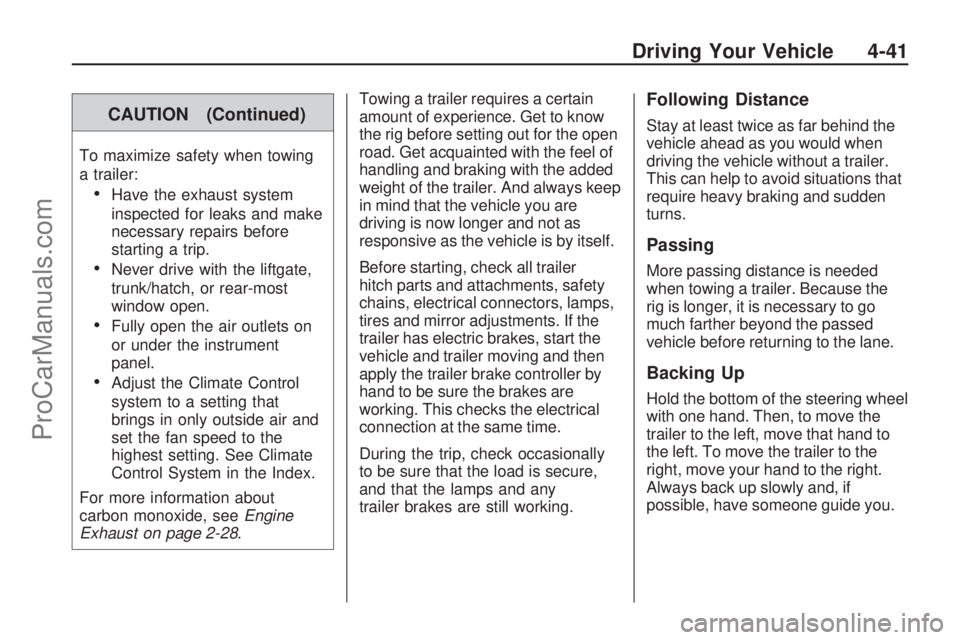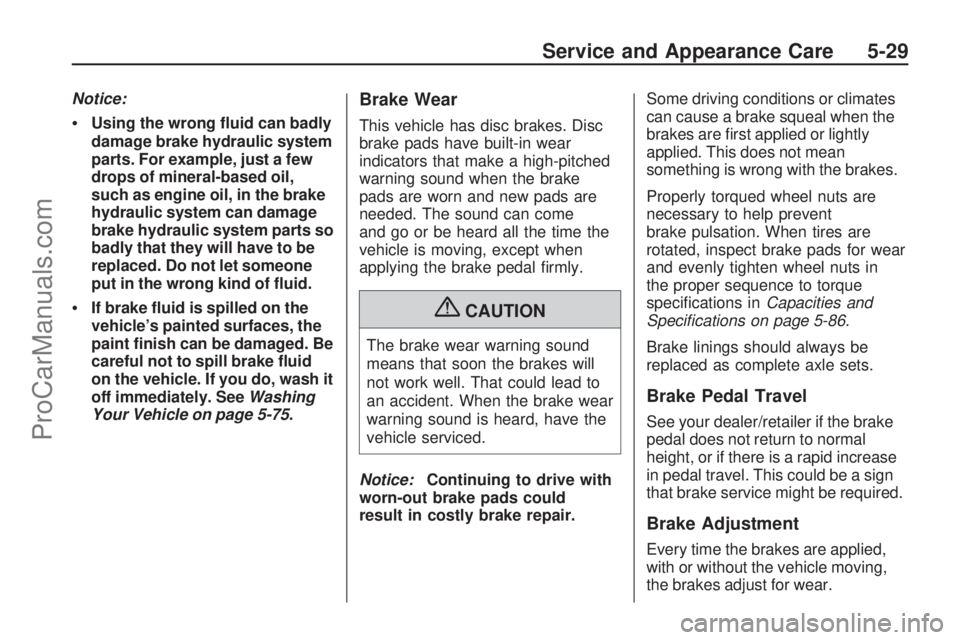tires SATURN VUE 2009 Owner's Manual
[x] Cancel search | Manufacturer: SATURN, Model Year: 2009, Model line: VUE, Model: SATURN VUE 2009Pages: 386, PDF Size: 2.3 MB
Page 231 of 386

Repeat this until help arrives but only
when you feel really uncomfortable
from the cold. Moving about to keep
warm also helps.
If it takes some time for help to
arrive, now and then when you run
the engine, push the accelerator
pedal slightly so the engine runs
faster than the idle speed. This
keeps the battery charged to restart
the vehicle and to signal for help with
the headlamps. Do this as little as
possible to save fuel.
If Your Vehicle is Stuck in
Sand, Mud, Ice, or Snow
Slowly and cautiously spin the
wheels to free the vehicle when
stuck in sand, mud, ice, or snow.
SeeRocking Your Vehicle to Get It
Out on page 4-27.If the vehicle has a traction system,
it can often help to free a stuck
vehicle. Refer to the vehicle’s
traction system in the Index. If stuck
too severely for the traction system
to free the vehicle, turn the traction
system off and use the rocking
method.
{CAUTION
If you let your vehicle’s tires spin
at high speed, they can explode,
and you or others could be
injured. The vehicle can overheat,
causing an engine compartment
�re or other damage. Spin the
wheels as little as possible and
avoid going above 35 mph
(55 km/h) as shown on the
speedometer.
For information about using tire
chains on the vehicle, seeTire
Chains on page 5-62.
Rocking Your Vehicle to
Get It Out
Turn the steering wheel left and right
to clear the area around the front
wheels. Turn off any traction or
stability system. Shift back and forth
between R (Reverse) and a forward
gear, or with a manual transmission,
between 1 (First) or 2 (Second) and
R (Reverse), spinning the wheels
as little as possible. To prevent
transmission wear, wait until the
wheels stop spinning before shifting
gears. Release the accelerator pedal
while shifting, and press lightly on
the accelerator pedal when the
transmission is in gear. Slowly
spinning the wheels in the forward
and reverse directions causes a
rocking motion that could free the
vehicle. If that does not get the
vehicle out after a few tries, it might
need to be towed out. If the vehicle
does need to be towed out, see
Towing Your Vehicle on page 4-32.
Driving Your Vehicle 4-27
ProCarManuals.com
Page 232 of 386

Loading the Vehicle
It is very important to know how
much weight your vehicle can
carry. This weight is called the
vehicle capacity weight and
includes the weight of all
occupants, cargo, and all
nonfactory-installed options.
Two labels on your vehicle show
how much weight it may properly
carry, the Tire and Loading
Information label and the
Certi�cation/Tire label.
{CAUTION
Do not load the vehicle any
heavier than the Gross Vehicle
Weight Rating (GVWR), or
either the maximum front or
rear Gross Axle Weight Rating
(GAWR). If you do, parts on
the vehicle can break, and it
can change the way your
(Continued)
CAUTION (Continued)
vehicle handles. These could
cause you to lose control and
crash. Also, overloading can
shorten the life of the vehicle.
Tire and Loading Information
Label
A vehicle speci�c Tire and
Loading Information label is
attached to the center pillar
(B-pillar) of your vehicle.With the driver’s door open, you
will �nd the label attached
below the door lock post
(striker). The tire and loading
information label shows the
number of occupant seating
positions (A), and the maximum
vehicle capacity weight (B) in
kilograms and pounds.
The Tire and Loading Information
label also shows the size of the
original equipment tires (C) and
the recommended cold tire
in�ation pressures (D). For more
information on tires and in�ation
seeTires on page 5-43and
Inflation - Tire Pressure on
page 5-49.
There is also important loading
information on the vehicle
Certi�cation/Tire label. It tells
you the Gross Vehicle Weight
Rating (GVWR) and the
Gross Axle Weight Rating
(GAWR) for the front and rear
axle. See “Certi�cation/Tire
Label” later in this section.
Example Label
4-28 Driving Your Vehicle
ProCarManuals.com
Page 237 of 386

To tow the vehicle from the front
with all four wheels on the ground:
1. Position the vehicle that will
be towed and secure it to
the towing vehicle.
2. Turn the ignition key to
ACC/ACCESSORY.
3. Shift the transmission to
N (Neutral).
4. Turn fog lamps and all
accessories off.5. To prevent the battery from
draining while the vehicle is
being towed, remove the 2 amp
IGN SW fuse from the instrument
panel fuse block and store it in a
safe location. SeeInstrument
Panel Fuse Block on page 5-80
Notice:If the vehicle is towed
without performing each of the
steps listed under “Dinghy
Towing,” the automatic
transmission could be damaged.
Be sure to follow all steps of the
dinghy towing procedure prior to
and after towing the vehicle.
Notice:If the vehicle has
a four-speed automatic
transmission, it can be dinghy
towed from the front for unlimited
miles at 65 mph (105 km/h).
The vehicle could be damaged If
65 mph (105 km/h) is exceeded
while towing the vehicle. The
repairs would not be covered
by the vehicle warranty. Never
exceed 65 mph (105 km/h) while
towing the vehicle.Once the destination has been
reached:
1. Set the parking brake.
2. Shift the transmission to
P (Park).
3. Reinstall the 2 amp IGN SW fuse
to the instrument panel fuse
block.
4. Turn the ignition key to LOCK/
OFF and remove the key from
the ignition.
Notice:Too much or too
little �uid can damage the
transmission. Be sure that the
transmission �uid is at the proper
level before towing with all four
wheels on the ground.
Notice:Do not tow a vehicle
with the front drive wheels on the
ground if one of the front tires is a
compact spare tire. Towing with
two different tire sizes on the front
of the vehicle can cause severe
damage to the transmission.
Driving Your Vehicle 4-33
ProCarManuals.com
Page 240 of 386

The following information has many
time-tested, important trailering tips
and safety rules. Many of these are
important for your safety and that of
your passengers. So please read this
section carefully before pulling a
trailer.
Load-pulling components such as
the engine, transmission, rear axle,
wheel assemblies and tires are
forced to work harder against the
drag of the added weight. The engine
is required to operate at relatively
higher speeds and under greater
loads, generating extra heat. The
trailer also adds considerably to wind
resistance, increasing the pulling
requirements.
The vehicle has Trailer Sway
Control (TSC). See “Trailer Sway
Control (TSC)” inStabiliTrak
®
System on page 4-7for more
information.
Pulling A Trailer
Here are some important points:
There are many different
laws, including speed limit
restrictions, having to do with
trailering. Make sure the rig will
be legal, not only where you
live but also where you will
be driving. A good source for
this information can be state or
provincial police.
Do not tow a trailer at all during
the �rst 500 miles (800 km)
the new vehicle is driven.
The engine, axle or other
parts could be damaged.
Then, during the �rst 500 miles
(800 km) that a trailer is towed, do
not drive over 50 mph (80 km/h)
and do not make starts at full
throttle. This helps the engine and
other parts of the vehicle wear in
at the heavier loads.
Vehicles can tow in D (Drive).
Shift the transmission to a lower
gear if the transmission shifts too
often under heavy loads and/or
hilly conditions.
Obey speed limit restrictions
when towing a trailer. Do not drive
faster than the maximum posted
speed for trailers, or no more than
55 mph (90 km/h), to save wear
on the vehicle’s parts.
Do not tow a trailer when the
outside temperature is above
100°F (38°C).
Three important considerations have
to do with weight:
The weight of the trailer
The weight of the trailer tongue
The total weight on the
vehicle’s tires
4-36 Driving Your Vehicle
ProCarManuals.com
Page 243 of 386

The weight at the rear axle could be
850 lbs (386 kg) X 1.5 = 1,275 lbs
(578 kg). Since the rear axle already
weighs 2,700 lbs (1 225 kg), adding
1,275 lbs (578 kg) brings the total to
3,975 lbs (1 803 kg). This is very
close to, but within the limit for
RGAWR as well. The vehicle is set to
trailer up to 8,500 lbs (3 856 kg).
If the vehicle has many options and
there is a front seat passenger and
two rear seat passengers with some
luggage and gear in the vehicle as
well, 300 lbs (136 kg) could be
added to the front axle weight and
400 lbs (181 kg) to the rear axle
weight. The vehicle now weighs:
Weight is still below 7,200 lbs
(3 266 kg) and you might think
700 additional pounds (318 kg)
should be subtracted from thetrailering capacity to stay within
GCWR limits. The maximum trailer
would only be 7,800 lbs (3 538 kg).
You may go further and think the
tongue weight should be limited to
less than 1,000 lbs (454 kg) to avoid
exceeding GVWR. But the effect on
the rear axle must still be considered.
Because the rear axle now weighs
3,100 lbs (1 406 kg), 900 lbs
(408 kg) can be put on the rear
axle without exceeding RGAWR.
The effect of tongue weight is about
1.5 times the actual weight. Dividing
the 900 lbs (408 kg) by 1.5 leaves
only 600 lbs (272 kg) of tongue
weight that can be handled. Since
tongue weight is usually at least
10 percent of total loaded trailer
weight, expect that the largest trailer
the vehicle can properly handle is
6,000 lbs (2 721 kg).It is important that the vehicle
does not exceed any of its
ratings — GCWR, GVWR, RGAWR,
Maximum Trailer Rating or Tongue
Weight. The only way to be sure it is
not exceeding any of these ratings is
to weigh the vehicle and trailer.
Total Weight on the Vehicle’s
Tires
Be sure the vehicle’s tires are
in�ated to the upper limit for cold
tires. These numbers can be found
on the Certi�cation label or see
Loading the Vehicle on page 4-28
for more information. Make sure not
to go over the GVW limit for the
vehicle, or the GAWR, including the
weight of the trailer tongue.
Driving Your Vehicle 4-39
ProCarManuals.com
Page 245 of 386

CAUTION (Continued)
To maximize safety when towing
a trailer:
Have the exhaust system
inspected for leaks and make
necessary repairs before
starting a trip.
Never drive with the liftgate,
trunk/hatch, or rear-most
window open.
Fully open the air outlets on
or under the instrument
panel.
Adjust the Climate Control
system to a setting that
brings in only outside air and
set the fan speed to the
highest setting. See Climate
Control System in the Index.
For more information about
carbon monoxide, seeEngine
Exhaust on page 2-28.Towing a trailer requires a certain
amount of experience. Get to know
the rig before setting out for the open
road. Get acquainted with the feel of
handling and braking with the added
weight of the trailer. And always keep
in mind that the vehicle you are
driving is now longer and not as
responsive as the vehicle is by itself.
Before starting, check all trailer
hitch parts and attachments, safety
chains, electrical connectors, lamps,
tires and mirror adjustments. If the
trailer has electric brakes, start the
vehicle and trailer moving and then
apply the trailer brake controller by
hand to be sure the brakes are
working. This checks the electrical
connection at the same time.
During the trip, check occasionally
to be sure that the load is secure,
and that the lamps and any
trailer brakes are still working.
Following Distance
Stay at least twice as far behind the
vehicle ahead as you would when
driving the vehicle without a trailer.
This can help to avoid situations that
require heavy braking and sudden
turns.
Passing
More passing distance is needed
when towing a trailer. Because the
rig is longer, it is necessary to go
much farther beyond the passed
vehicle before returning to the lane.
Backing Up
Hold the bottom of the steering wheel
with one hand. Then, to move the
trailer to the left, move that hand to
the left. To move the trailer to the
right, move your hand to the right.
Always back up slowly and, if
possible, have someone guide you.
Driving Your Vehicle 4-41
ProCarManuals.com
Page 249 of 386

Service and
Appearance Care
ServiceService................................5-3
Accessories and
Modi�cations.......................5-3
California Proposition 65
Warning.............................5-4
California Perchlorate
Materials Requirements........5-4
Doing Your Own
Service Work......................5-4
Adding Equipment to the
Outside of the Vehicle...........5-5
FuelFuel....................................5-5
Gasoline Octane...................5-5
Gasoline Speci�cations..........5-6
California Fuel......................5-6
Additives..............................5-6
Fuels in Foreign Countries......5-8
Filling the Tank.....................5-8
Filling a Portable Fuel
Container..........................5-10
Checking Things Under
the Hood
Checking Things Under
the Hood..........................5-10
Hood Release.....................5-11
Engine Compartment
Overview..........................5-12
Engine Oil..........................5-14
Engine Oil Life System.........5-16
Engine Air Cleaner/Filter.......5-17
Automatic Transmission
Fluid................................5-18
Cooling System...................5-19
Engine Coolant...................5-22
Coolant Surge Tank
Pressure Cap....................5-25
Engine Overheating.............5-25
Power Steering Fluid............5-26
Windshield Washer Fluid......5-27
Brakes...............................5-28
Battery...............................5-30
Jump Starting.....................5-31
All-Wheel DriveAll-Wheel Drive...................5-35
Headlamp AimingHeadlamp Aiming................5-36
Bulb ReplacementBulb Replacement...............5-39
Halogen Bulbs....................5-39
Headlamps.........................5-39
Front Turn Signal and
Parking Lamps..................5-40
Taillamps, Turn Signal,
Stoplamps and Back-up
Lamps..............................5-40
License Plate Lamp.............5-41
Replacement Bulbs..............5-41
Windshield Wiper Blade
Replacement
Windshield Wiper Blade
Replacement.....................5-42
TiresTires..................................5-43
Tire Sidewall Labeling..........5-44
Tire Terminology and
De�nitions.........................5-46
In�ation - Tire Pressure........5-49
High-Speed Operation..........5-50
Tire Pressure Monitor
System.............................5-51
Tire Pressure Monitor
Operation..........................5-53
Service and Appearance Care 5-1
ProCarManuals.com
Page 250 of 386

Tire Inspection and
Rotation............................5-56
When It Is Time for
New Tires.........................5-57
Buying New Tires................5-58
Different Size Tires and
Wheels.............................5-59
Uniform Tire Quality
Grading............................5-60
Wheel Alignment and
Tire Balance.....................5-61
Wheel Replacement.............5-62
Tire Chains.........................5-62
If a Tire Goes Flat...............5-63
Changing a Flat Tire............5-64
Removing the Spare
Tire and Tools...................5-65
Removing the Flat Tire and
Installing the Spare Tire.......5-66
Storing a Flat or Spare
Tire and Tools...................5-70
Compact Spare Tire.............5-71Appearance CareInterior Cleaning..................5-72
Fabric/Carpet......................5-73
Leather..............................5-74
Instrument Panel, Vinyl, and
Other Plastic Surfaces.........5-74
Care of Safety Belts............5-74
Weatherstrips......................5-75
Washing Your Vehicle..........5-75
Cleaning Exterior
Lamps/Lenses...................5-75
Finish Care.........................5-76
Windshield and Wiper
Blades..............................5-76
Aluminum Wheels................5-77
Tires..................................5-77
Sheet Metal Damage...........5-78
Finish Damage....................5-78
Underbody Maintenance.......5-78
Chemical Paint Spotting........5-78Vehicle Identi�cationVehicle Identi�cation
Number (VIN)....................5-79
Service Parts Identi�cation
Label...............................5-79
Electrical SystemAdd-On Electrical
Equipment........................5-79
Windshield Wiper Fuses.......5-80
Power Windows and
Other Power Options..........5-80
Fuses and Circuit
Breakers...........................5-80
Instrument Panel
Fuse Block.......................5-80
Underhood Fuse Block.........5-82
Capacities and
Speci�cations
Capacities and
Speci�cations....................5-86
5-2 Service and Appearance Care
ProCarManuals.com
Page 277 of 386

Notice:
Using the wrong �uid can badly
damage brake hydraulic system
parts. For example, just a few
drops of mineral-based oil,
such as engine oil, in the brake
hydraulic system can damage
brake hydraulic system parts so
badly that they will have to be
replaced. Do not let someone
put in the wrong kind of �uid.
If brake �uid is spilled on the
vehicle’s painted surfaces, the
paint �nish can be damaged. Be
careful not to spill brake �uid
on the vehicle. If you do, wash it
off immediately. SeeWashing
Your Vehicle on page 5-75.
Brake Wear
This vehicle has disc brakes. Disc
brake pads have built-in wear
indicators that make a high-pitched
warning sound when the brake
pads are worn and new pads are
needed. The sound can come
and go or be heard all the time the
vehicle is moving, except when
applying the brake pedal �rmly.
{CAUTION
The brake wear warning sound
means that soon the brakes will
not work well. That could lead to
an accident. When the brake wear
warning sound is heard, have the
vehicle serviced.
Notice:Continuing to drive with
worn-out brake pads could
result in costly brake repair.Some driving conditions or climates
can cause a brake squeal when the
brakes are �rst applied or lightly
applied. This does not mean
something is wrong with the brakes.
Properly torqued wheel nuts are
necessary to help prevent
brake pulsation. When tires are
rotated, inspect brake pads for wear
and evenly tighten wheel nuts in
the proper sequence to torque
speci�cations inCapacities and
Specifications on page 5-86.
Brake linings should always be
replaced as complete axle sets.
Brake Pedal Travel
See your dealer/retailer if the brake
pedal does not return to normal
height, or if there is a rapid increase
in pedal travel. This could be a sign
that brake service might be required.
Brake Adjustment
Every time the brakes are applied,
with or without the vehicle moving,
the brakes adjust for wear.
Service and Appearance Care 5-29
ProCarManuals.com
Page 284 of 386

How to Check Lubricant
A. Fill Plug
B. Drain Plug
To get an accurate reading, the
vehicle should be on a level surface.If the level is below the bottom of
the �ller plug hole, you’ll need to
add some lubricant. Add enough
lubricant to raise the level to the
bottom of the �ller plug hole. A �uid
loss could indicate a problem; check
and have it repaired, if needed.
What to Use
Refer to the Maintenance Schedule
to determine what kind of lubricant
to use. SeeRecommended
Fluids and Lubricants on page 6-13.Headlamp Aiming
The headlamp aiming system has
been preset at the factory.
If the vehicle is damaged in an
accident, the aim of the headlamps
may be affected and adjustment
may be necessary.
It is recommended that a
dealer/retailer adjust the headlamps.
To re-aim the headlamps yourself,
use the following procedure.
The vehicle should be properly
prepared as follows:
The vehicle should be placed so
the headlamps are 25 ft. (7.6 m)
from a light colored wall.
The vehicle must have all four
tires on a level surface which
is level all the way to the wall.
The vehicle should be placed so
it is perpendicular to the wall or
other �at surface. AWD Differential Case
5-36 Service and Appearance Care
ProCarManuals.com